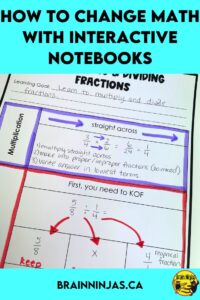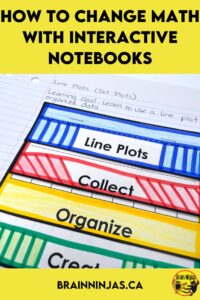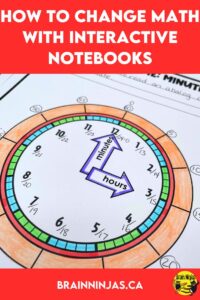
When a colleague told us we should try interactive notebooks in math, we agreed and then went on our merry ways and did math the same old way for another year.
At the end of that school year, she approached us again and DEMANDED we buy an Interactive Math Journal lesson plan set. We took a look, bought it and then went on summer vacation, never to think about math for a whole two months.
Near the end of the summer, we opened it up and it CHANGED OUR WORLD. We will never teach math the same way again. That being said, there are a few things we learned about the process and we wanted to share these tips with you so you don’t have to spend so much time figuring things out yourself.
Interactive math notebooks are an investment, but like all good investments, they take time to show a good return. Patience is the key! They take time, but they result in deeper understanding, so here are some things you need to know to get the most out of your interactive math notebook journey.
Here are the problems with interactive math journals and how we conquered them.

The Problem: Likeability
Students don’t like them.
The Solution
Not all of your students are going to like every single thing you do in your classroom because no one is perfect. That being said, your positive attitude can be contagious, so be sure to speak as positively about your lessons as you can. They were more convinced as their understanding of math concepts improved over the year.
The Problem: Numbering
Writing page numbers in order is hard for some students. We started at the beginning of the year, writing page numbers on the corners of every page. It was excruciating. Some students couldn’t keep track, others missed a page and had to go back and renumber them.
The Solution
We number the pages a few at a time as we go through the year. This also makes it easier to keep the Table of Contents up to date. We used a few minutes at the beginning of each week to sort out page numbers before diving into the new lessons.
Ninja Note: All our ninjas-in-training can write their numbers to 100 without missing or skipping any pages now. 🙂
The Problem: Take up time
Interactive math notebooks are time-consuming.
The Solution
Yes, but you can help streamline how you get them to work for you with some of our time-saving tips later in this post. Using interactive math notebooks can free up some of your teaching time since students can use their books to refer to examples while they are working independently. This means you can use this time to target specific students, work with small groups or assess students as they work.

The Problem: They fall apart
Durability is an issue because the books can fall apart and can’t be used all year. We used notebooks with a metal coil and cardboard covers during our first year of journaling. While most of them held up, the ones that fell apart had no way to be repaired. Once a page fell out, the book became more of a folder and then pages got lost, never to be seen again. We tried out composition notebooks, but when students made mistakes (like gluing their pages shut), it was hard to replace pages.
The Solution
We preferred duotangs (report covers that are 3-hole punched) with plastic covers. We filled them with lined paper and they held up very well. It’s also quite easy to replace pages. If you have suggestions of systems you’ve used with success, let us know in the comments below.
The Problem: Takes work
It’s too much work to be organized.
The Solution
Yes, it is work. We used a hanging file folder set to keep all of our templates, proof questions and practice pages once they were copied and ready to use. Set out one copy of each of the templates (by printing them directly from our digital download) and have a helper make the copies for us. We did this once a month, right before our cut and glue day. This “batching” reduced the workload and helped us stay organized.
The Problem: Make extra work
Aren’t interactive math journals just a make-work project?
The Solution
If you are having your students make the template pages, but then they place their books on the shelf or in a drawer, not be seen again until the next lesson, they yes. It’s a make-work project.
That’s not the intention of interactive notebooks. The keyword is INTERACT. For us, this means we refer to the template pages ALL THE TIME. We use them for studying, independent practice, assessments and just about every single time we have math class.
The Problem: Missing students
Students who are absent end up missing pages and never have time to catch up.
The Solution
We started doing this near the end of the year but wished we had started sooner. Make photocopies or take photos of the completed lesson pages so students can complete them independently if they’ve been absent. This also helps when absent-minded ninjas leave the master copy elsewhere and it takes ninja superpowers to relocate it. Have your high-flying students cut out an extra template and have it already attached to the page for the returning student.

The Problem: Fine-motor skills
Not all students can cut, paste, glue and write in the same amount of time, so it makes whole class instruction challenging.
The Solution
Make modifications for all of your students. We had a few students that had fine motor difficulty. One modification we made was having the curriculum expectation typed out so students could focus on the lesson. We also had “scissor buddies.” These were students who worked quickly and would cut out templates for pages on behalf of other students or for students who were absent or needed assistance.
We also had one student who would write out their proof page on a device and then would draw on any math symbols needed. This would be printed out and then pasted into the math journal. Making modifications in advance of needing them saves everyone time but allows you to continue with whole-class instruction.
The Problem: Not enough math
All that cutting and gluing takes up most of the math lesson. It just doesn’t seem worth it.
The Solution
Try having a “cut and glue day” where you just cut out templates and attach them to pages. That way, when it’s time to complete the lessons, you just have to write without the finding of scissors and glue and all the mess. We managed to get a month’s worth of templates cut and glued with titles onto our pages within an hour.
This sounds like a lot of time, but it meant every lesson for the next month started right away and no extra time was wasted looking for scissors or glue or anything else.
Ninja Note: If you have a student absent on cut and glue day, use their book as the example for students under the document camera and set up their pages yourself as a demonstration.
The Problem: Not my district’s program
I’m supposed to be using the textbook my district provides.
The Solution
Yes, that is what you use to practice all the math skills or show examples as you build the templates.
We found our students depended on these books for everything and they became invaluable. Students became very protective of them and no one took them home. We made copies of pages if students needed to use them at home. They used them as a resource and many students wanted to keep them to use again next year.
It made us think so clearly about the outcomes, the teaching and the assessment that we will be using interactive notebooks in other subjects in the future.
The Problem: I don’t think it’s worth it
I don’t think it’s going to work.
The Solution
You won’t know what works for you until you try. We didn’t think it would work for us until we tried it. Once we got through the “scaries” and figured out a few ways to streamline the process for our students, we were so shocked at how well it became part of our routine. Students started to know and understand how the process worked and they learned the material SO MUCH BETTER. That in itself is worth the effort.

The Problem: Too much stuff
I don’t know where to start. It’s so overwhelming trying to figure out what to teach and when or what materials to use.
The Solution
We used to piecemeal our lessons and activities from all over the place, but we found the most useful thing we did was create our versions of the interactive math notebook that was specific to the outcomes that we needed to teach. Now they are in our store to save other teachers time. We have aligned the lessons to Alberta, BC and Saskatchewan with a guide to tell you which lessons to use. Best of all, we know have a Canadian fund option so schools can buy directly for you (translation: teachers don’t have to buy resources out of their own pockets).
So, you have Interactive Math Units on the brain and want to give them a try?
Our Interactive Math Notebooks include all our engaging lesson plan templates, complete lesson plans for teachers, activities for students to use to reinforce concepts, practice pages for students to use and assessments that you can use to check to see if your students understand everything you’ve taught.
We specifically design math lessons for Alberta, British Columbia and Saskatchewan, but they can be used across Canada. All of our lessons use the metric system and SI notation (that’s where we use spaces like 84 292 instead of commas like 84,292).
Grade 3 Interactive Units
Number Concepts (Including Fractions) – TpT Store ($USD) or our BN Shop ($CAN)
Number Operations – TpT Store ($USD) or our BN Shop ($CAN)
Statistics and Graphing – TpT Store ($USD) or our BN Shop ($CAN)
Patterns and Relations – TpT Store ($USD) or our BN Shop ($CAN)
Time and Measurement – TpT Store ($USD) or our BN Shop ($CAN)
Geometry – TpT Store ($USD) or our BN Shop ($CAN)
The Bundle – TpT Store ($USD) or our BN Shop ($CAN)
Grade 4 Interactive Units
Number Concepts – TpT Store ($USD) or our BN Shop ($CAN)
Number Operations – TpT Store ($USD) or our BN Shop ($CAN)
Decimals and Fractions – TpT Store ($USD) or our BN Shop ($CAN)
Patterns and Algebra – TpT Store ($USD) or our BN Shop ($CAN)
Statistics and Probability – TpT Store ($USD) or our BN Shop ($CAN)
Reading Clocks and Elapsed Time – TpT Store ($USD) or our BN Shop ($CAN)
Measurement – TpT Store ($USD) or our BN Shop ($CAN)
Geometry – TpT Store ($USD) or our BN Shop ($CAN)
The Bundle – TpT Store ($USD) or our BN Shop ($CAN)
Grade 4/5 Combined Class Interactive Units
Number Concepts – TpT Store ($USD) or our BN Shop ($CAN)
Number Operations – TpT Store ($USD) or our BN Shop ($CAN)
Decimals and Fractions – TpT Store ($USD) or our BN Shop ($CAN)
Statistics and Probability – TpT Store ($USD) or our BN Shop ($CAN)
Patterns and Algebra – TpT Store ($USD) or our BN Shop ($CAN)
Reading Clocks and Elapsed Time – TpT Store ($USD) or our BN Shop ($CAN)
Measurement – TpT Store ($USD) or our BN Shop ($CAN)
Geometry Concepts – TpT Store ($USD) or our BN Shop ($CAN)
The Bundle – TpT Store ($USD) or our BN Shop ($CAN)
Grade 5 Interactive Units
Number Concepts – TpT Store ($USD) or our BN Shop ($CAN)
Number Operations – TpT Store ($USD) or our BN Shop ($CAN)
Decimals, Fractions, Ratios, and Percent – TpT Store ($USD) or our BN Shop ($CAN)
Patterns and Algebra – TpT Store ($USD) or our BN Shop ($CAN)
Statistics and Probability – TpT Store ($USD) or our BN Shop ($CAN)
Calculating Elapsed Time – TpT Store ($USD) or our BN Shop ($CAN)
Measurement – TpT Store ($USD) or our BN Shop ($CAN)
Geometry – TpT Store ($USD) or our BN Shop ($CAN)
The Bundle – TpT Store ($USD) or our BN Shop ($CAN)
Grade 5/6 Combined Class Interactive Units
Number and Integer Concepts – TpT Store ($USD) or our BN Shop ($CAN)
Number Operations – TpT Store ($USD) or our BN Shop ($CAN)
Decimals, Fractions, Ratios, and Percent – TpT Store ($USD) or our BN Shop ($CAN)
Statistics and Probability – TpT Store ($USD) or our BN Shop ($CAN)
Patterns and Algebra – TpT Store ($USD) or our BN Shop ($CAN)
Calculating Elapsed Time – TpT Store ($USD) or our BN Shop ($CAN)
Measurement – TpT Store ($USD) or our BN Shop ($CAN)
Geometry Concepts – TpT Store ($USD) or our BN Shop ($CAN)
The Bundle – TpT Store ($USD) or our BN Shop ($CAN)
Grade 6 Interactive Units
Number and Integer Concepts – TpT Store ($USD) or our BN Shop ($CAN)
Number Operations – TpT Store ($USD) or our BN Shop ($CAN)
Decimals, Fractions, Ratios, and Percent – TpT Store ($USD) or our BN Shop ($CAN)
Patterns and Algebra – TpT Store ($USD) or our BN Shop ($CAN)
Statistics and Probability – TpT Store ($USD) or our BN Shop ($CAN)
Measurement – TpT Store ($USD) or our BN Shop ($CAN)
Geometry – TpT Store ($USD) or our BN Shop ($CAN)
The Bundle – TpT Store ($USD) or our BN Shop ($CAN)
And the Unexpected Bonus?
We realized it was much easier to differentiate for our students with the range of outcomes. No class will ever have every single student working at grade level (and if you do, let us know how you managed that). So, if you have a bright grade four class, you can challenge them a little. If you have a weaker grade five class, you can help reinforce some of the concepts.
You can read more about how we differentiate by reading these posts: How to Differentiate Your Instruction and How to Differentiate in Less Time.
For our students who need a challenge, we like to use this Error Analysis Activity. You can find it in our Resource Library or we can send it directly to your inbox when you join our email list.
Teaching Elementary Math?
You might find these posts helpful:
- The Truth About New Math
- Conquer Math With These Proven Multiplication Strategies
- The Trouble With Task Cards and How to Fix It
- Math Worksheet Games Your Students Will Love
- How to Use Interactive Notebooks to Teach Number Sense
- Ways to Teach Shape and Space Concepts
- How to Teach Students to Analyze Errors in Math
- Ways to Bring Graphing Activities into Your Classroom Daily
- How to Help Your Students Master Decimal Operations
- How to Add Candy to Your Math Lessons
- How To Teach Successful Long Division Strategies
- How to Make Teaching Patterns Painless
What has your experience been with using interactive math notebooks? Do you have other tips or tricks that you have learned while using interactive notebooks? Are you struggling with a problem that we didn’t mention? Share your ideas with us in the comments below.







